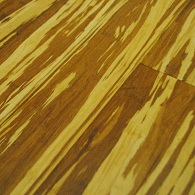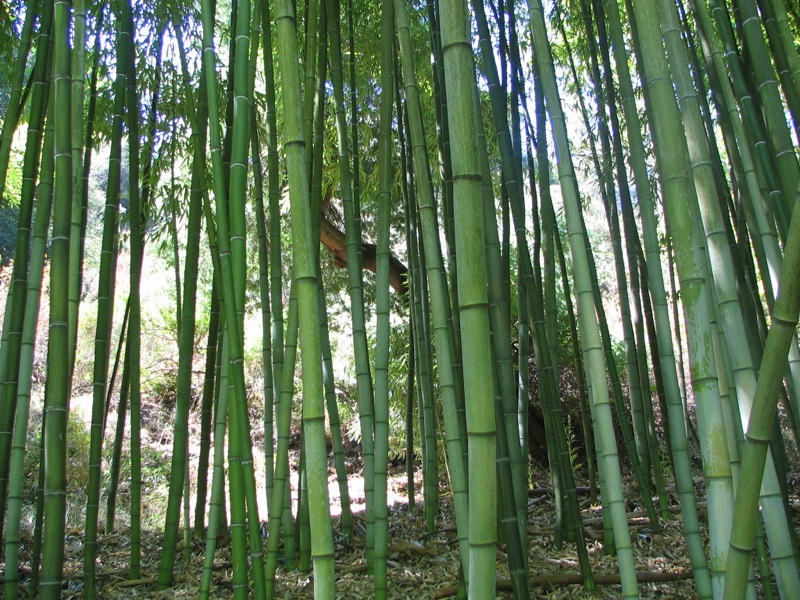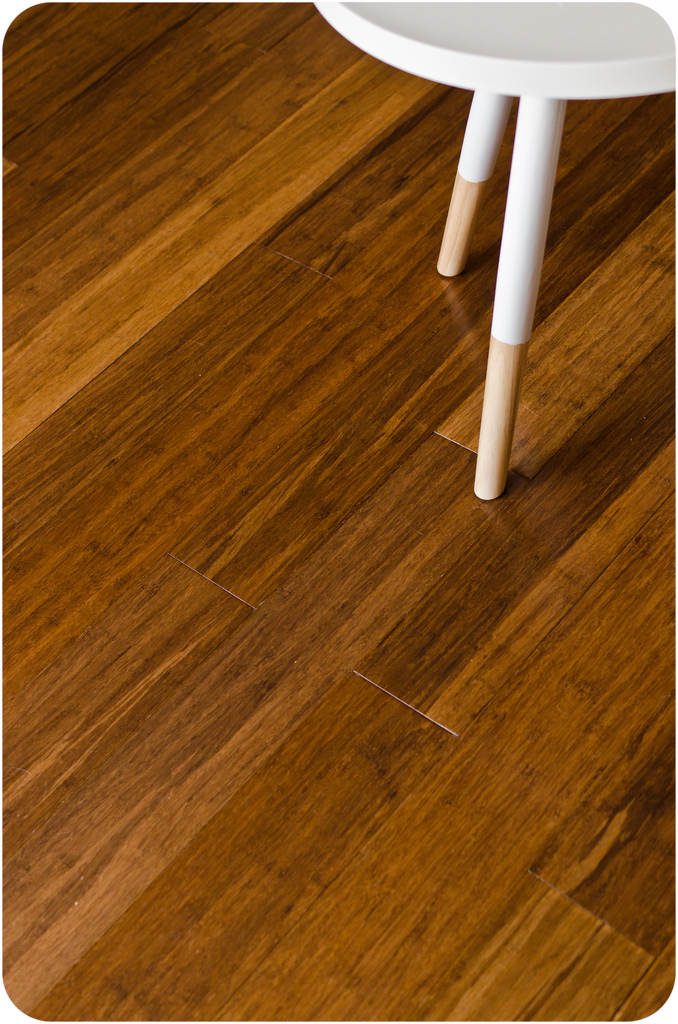Bamboo Flooring

|
One of the biggest reasons people choose bamboo, though, isn’t the look, but rather the environmental benefits, mainly its amazing sustainability. It’s one of the fastest growing plants on planet Earth, and when it finishes its growing cycle, its own roots spread out and started new plants. This means it regenerates even if it is not replanted, and after that a bamboo plant needs little attention and little in the way of pesticides. The plant itself can grow up to three feet a day, ending up 125 feet tall and two feet in diameter. The major suppliers of the kind of bamboo used to make flooring are the Philippines, Korea, Indonesia, Vietnam and China, which is the largest producer. Fortunately, the kind of bamboo you might find yourself walking on is not the kind used as a habitat and food source for the endangered Giant Panda. So, what is bamboo?
 See? It really is grass! Bamboo flooring is often categorized with hardwood, probably to simplify the shopping process for the customer, because they are very similar in how they are installed, how they are cared for, and where they can be installed. If you are shopping for a floor, you’re more likely to switch to real bamboo if you were already considering a real hardwood floor, less likely if you were looking at vinyl or laminate. Functionally, the main difference between the two is that grass is not as porous as wood, so bamboo floors are a slightly better choice to make for the kitchen, where spills may happen here or there. Bamboo and hardwood also have competing environmental benefits. With hardwood, the possible negative is that the source of the timber might be a disreputable logger who strips forests bare, or harvests rare or exotic trees, decreasing the species’ sustainability. Bamboo is unbelievably replenishable. In fact, it does the work for us, if we’re asleep at the regrowth wheel. Bamboo can shoot up 3 feet per day, topping at 125 feet high by 2 feet in diameter. Once done growing, it spreads its roots out and starts new plants, all by its own self. Cut it down, and it grows back. Don’t cut it down, and it grows back anyway.
So it’s a big, new trend in flooring. Now, there are two types of colors, and two types of patterns. For colors, we have what are called natural and carbonized bamboo. Natural is just what it sounds like. The coloring resembles beech wood… the, uh, look of which we’ve all just memorized, haven’t we? Sorry, that was an esoteric comparison. Basically it’s light, yellow-ish, and best judged with the eyes, so check out our photos here or on our discount flooring site, or get a sample if we have something you’re really interested in. Carbonized bamboo is basically treated with heat to darken the grass to varying degrees. Generally, this more brown bamboo will resemble the color of caramel.
The patterns are just as simple. Horizontal and vertical describe how the pieces of bamboo are joined. The individual pieces of bamboo are flat and rectangular, roughly the same shape as a 2 x 4, but smaller. It takes quite a few of these to make one plank. They can be stacked vertically, so that if you look at the top of your board you’ll be seeing the edges of the piece of bamboo. It’s not as stark as it looks in these drawings. They’re just here to illustrate the layout of the bamboo pieces.  Vertical Bamboo Flooring They can also be stacked horizontally, staggered like bricks from layer to layer, such that when you look at the top of your board, you’ll see the flat, top part of the bamboo. The overall pattern with horizontal bamboo is of fewer, wider strips used to make the plank.  Horizontal Bamboo Flooring Basically, vertical bamboo just has a busier look to its surface. There is no disadvantage to either as far as durability and usability. It really just affects how the floor will look. In a category of its own is Strand Woven Bamboo, sort of the laminate flooring of the bamboo world. What happens is that the bamboo pieces get shredded, then glued back together as smaller, denser fibers. These are heavier, stronger, more durable floors. Both the ‘Natural’ and ‘Carbonized’ pictures above are of the strand woven type.  Strand Woven Bamboo Flooring
Where hardwood has a potential environmental advantage over bamboo is in the manufacturing. Hardwood is wood milled into a board. Even engineered hardwood, where layers of wood are combined into one board, are formed in environmentally sensible ways. Bamboo can pose a problem because of the adhesives used to make it. Almost all bamboo flooring is made out of the country, where the bamboo grows. Standards are different in different places, and not everyone follows standards anyway. Some manufacturers use a lot of cheap adhesives without regard to the chemicals they might emit into the air, so if you’re considering bamboo, do a serious check into the formaldehyde content of the material before you bring it into your home. At Floors To Your Home, we won’t sell material that doesn’t meet U.S. standards. We don’t make the products ourselves, so we have to trust the manufacturers, but for that reason we only do business with manufacturers we trust. To the best of our knowledge we don’t carry any products that contain any formaldehyde. When we can get decent bamboo flooring, we will carry it, and you just go right ahead and ask us about chemicals or anything else if you’re checking out our products. When we can’t get good, real bamboo, we keep around both vinyl and laminate with bamboo looks so customers can get the best of both worlds, the distinctive bamboo style and the safety and flexibility of those two kinds of flooring.
|

|

|
Bamboo comes in two basic colors, though both colors have a pretty broad range of shades. Though it is given a bleaching treatment, Natural Bamboo has a very natural look. It’s said to resemble beech. Carbonized Bamboo is put through a heat and steam process that darkens the grass, and the darkening can be controlled. More time in the heat means darker bamboo. Carbonized bamboo often has a caramel color tone.
Bamboo also comes in two main patterns, vertical and horizontal. It’s simply a matter of how the slats of bamboo are bound to make the planks. Both patterns are available in both colors. A third type is called Strand Woven Bamboo. Here the bamboo is shredded and then glued together. This makes the flooring very heavy, and extra durable. A lot of these products use a large quantity of cheap glues, so you would want to look into the formaldehyde content if you look at this kind of bamboo for your home.
Bamboo is more decorative than it is durable. Compared to hardwood, it is
softer than oak, and much closer to maple in hardness. Just as softer woods
are dented by heavy furniture and can be scratched by even normal use, so is
it with bamboo. A good bamboo floor plank will be made of harder material,
and coated with up to seven or eight coats of a scratch resistant substance
called acrylic aluminum oxide enhanced poly. Less quality bamboo will be
made of softer material, and will have fewer coats of the finish, sometimes
as low as just two. Bamboo can be secured to your
subfloor
using the installation methods common to hardwood, but depending on the
manufacture, it can also be installed in a
floated
method.
Related Blog Post: What is a Bamboo Floor?
https://www.floorstoyourhome.com/blog/2012/03/wha...
– – – –
David has written and made videos about flooring products and installation since 2011 at Floors To Your Home (.com), where he is also the PPC Manager, a Researcher, a Website & Marketing Strategy Team member, Videographer, Social Strategist, Photographer and all around Resource Jito. In my spare time I shoot and edit video, put together a podcast, explore film history, and mix music (as in ‘play with Beatles multi-tracks’). Connect with
W. David Lichty
Follow Team Floors To Your Home on Facebook

 Brown Tone
Brown Tone
 Unfinished
Unfinished
 Red Tone
Red Tone
 Golden Tone
Golden Tone
 Gray Tone
Gray Tone
 Light Tone
Light Tone
 Medium Tone
Medium Tone
 Dark Tone
Dark Tone
 Brown Tone
Brown Tone
 Red Tone
Red Tone
 Golden Tone
Golden Tone
 Gray Tone
Gray Tone
 Light Tone
Light Tone
 Medium Tone
Medium Tone
 Dark Tone
Dark Tone
 Brown Tone
Brown Tone
 Red Tone
Red Tone
 Golden Tone
Golden Tone
 Gray Tone
Gray Tone
 Light Tone
Light Tone
 Medium Tone
Medium Tone
 Dark Tone
Dark Tone
 Multi Color
Multi Color















